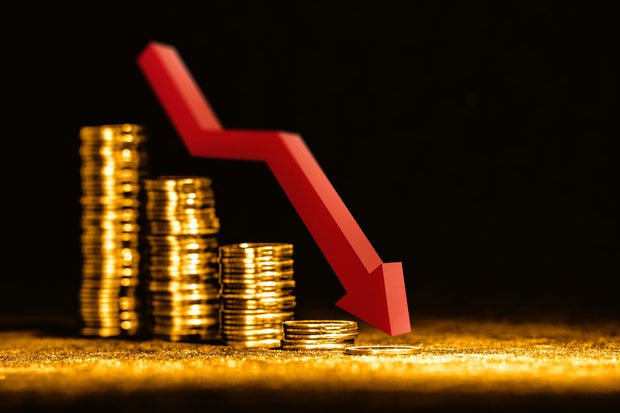Gold’s price is plunging. Here’s why (and what investors should do next).
October 22, 2025

Getty Images/iStockphoto
Gold has had an extraordinary run over the past year. The precious metal has climbed steadily in price since the start of 2025 and recently surpassed both expert and analyst expectations when the price closed in on $4,380 per ounce — marking an uptick of over 60% in less than 10 months. That particular gold price rally was driven by familiar forces: inflation concerns, geopolitical uncertainty and robust buying from central banks worldwide.
This week, though, the price momentum took a sharp turn in the opposite direction. On October 21, gold experienced its steepest single-day decline in over 12 years, falling by over 6% and losing close to $300 per ounce. Silver followed suit with an even larger drop of roughly 9%. The abrupt sell-off caught many investors off guard, especially after witnessing gold’s epic ascent. And, gold has continued to fall further in the days since, with the price of gold currently sitting at just over $4,000 per ounce.
As a result, questions are emerging about what exactly is impacting the landscape and how to best handle this sudden downturn. Below, we’ll examine the cause behind this dip in the price of gold and what moves investors should make next.
Find out how to add gold to your investment portfolio today.
Here’s why the price of gold is plunging
Right now, several key factors are converging to help explain why gold’s price is under pressure, including:
Profit-taking after a massive run
Gold prices surged this year as investors clamoured for refuge due to widespread economic uncertainty. But when an asset runs hard, the risk of profit-taking rises, and that is exactly what seems to be happening. Analysts point to the recent sharp drop as partly a reaction to gold investors cashing out their gains. And, once profits start to be locked in, momentum can reverse quickly in an asset like gold.
Learn more about the benefits of gold investing now.
A stronger U.S. dollar and rising real yields
Because gold is priced in dollars, when the U.S. dollar strengthens, it tends to make gold more expensive for non-U.S. investors, and, in turn, there’s less demand. That’s precisely what happened here. The dollar went up on the day of the decline, and as a result, gold became more expensive for international buyers, which naturally dampened the demand. Currency movements like these consistently influence the precious metal’s appeal to global investors.
Easing geopolitical and economic fears
Gold tends to thrive when the world looks unstable due to issues like war, trade concerns, inflation and uncertain policy. But if some of those fears fade, the demand for gold as a hedge can shrink. There are signs of that happening right now, like easing trade tensions between the U.S. and China, which is likely having an impact on the price of gold. Markets are also showing signs of greater risk tolerance, and when risk appetite returns, assets like stocks benefit, but gold tends to suffer. In combination, these factors help to explain the dramatic pull-back we’ve seen.
Here’s what investors should do next
The current gold price environment isn’t necessarily a crisis. It’s more of a turning point. For investors, that means thinking about strategy. Here’s what gold investors may want to do next:
Consider adding or adjusting, not abandoning, gold. If you believe in gold’s long-term role as a hedge (against inflation, debt, systemic risks, etc.), then this pull-back can be an opportunity. Lower prices can allow you to layer in positions with dollar-cost averaging rather than chasing peaks. Now may be a better entry point than when prices were near record highs.
Look at physical gold and diversification. Holding physical bullion can give you another dimension of exposure. But don’t over-allocate. Gold should be part of a diversified portfolio, not the whole thing. Also consider other instruments (gold ETFs or gold mining stocks) if storage or logistics are an issue.
Be selective and flexible. Not all gold exposure is the same. Mining stocks, gold ETFs and physical bullion each have different risk/return profiles. You should also keep an eye on the triggers like interest rate changes, inflation data and geopolitics to help determine the right moves.
Watch the signals. Key data points matter. Inflation numbers, central-bank commentary, dollar index trends, trade or geopolitical developments all play a role in informing how gold may move next. If inflation accelerates unexpectedly or a new global shock appears, gold could rebound. If inflation stays tame and risk appetite stays strong, gold may struggle.
Keep risk in check. If you already own gold and are worried about further drops, consider reducing exposure modestly. Don’t get caught in a full sell-off if you believe in the long-term benefits, but don’t ignore the possibility of further downsides either.
The bottom line
The sell-off in gold’s price is not a random glitch. It’s the result of several interlinked forces. And, for investors, this moment presents both risk and opportunity. If you see gold as a long-term hedge, the current dip may be a chance to buy in or re-balance. But if your thesis was solely based on gold being the place to shelter and that narrative is shifting, then it may be time to reassess your position. Ultimately, balance, timing and clarity about your investing goals is key.
Search
RECENT PRESS RELEASES
Related Post



